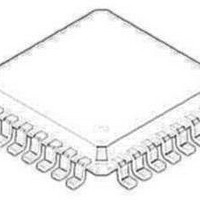NCP5331FTR2G ON Semiconductor, NCP5331FTR2G Datasheet - Page 16

NCP5331FTR2G
Manufacturer Part Number
NCP5331FTR2G
Description
IC CTLR PWM 2PH W/DRVRS 32-LQFP
Manufacturer
ON Semiconductor
Datasheet
1.NCP5331FTR2G.pdf
(36 pages)
Specifications of NCP5331FTR2G
Applications
Controller, AMD Athlon™
Voltage - Input
9 ~ 14 V
Number Of Outputs
2
Voltage - Output
5V
Operating Temperature
0°C ~ 70°C
Mounting Type
Surface Mount
Package / Case
32-LQFP
Mounting Style
SMD/SMT
Lead Free Status / RoHS Status
Lead free / RoHS Compliant
Other names
NCP5331FTR2G
NCP5331FTR2GOSTR
NCP5331FTR2GOSTR
Available stocks
Company
Part Number
Manufacturer
Quantity
Price
Company:
Part Number:
NCP5331FTR2G
Manufacturer:
ON Semiconductor
Quantity:
10 000
Part Number:
NCP5331FTR2G
Manufacturer:
ON/安森美
Quantity:
20 000
microseconds of a transient before the feedback loop has
repositioned the COMP pin.
fixed level. Before time T1 the converter is in normal steady
state operation. The inductor current provides a portion of
the PWM ramp through the Current Sense Amplifier. The
PWM cycle ends when the sum of the current ramp, the
internal ramp voltage and Startup OFFSET exceed the
voltage level of the COMP pin. At T1 the output current
increases and the output voltage sags. The next PWM cycle
begins and this PWM cycle continues longer than
previously. As a result, the current signal increases enough
to make up for the lower voltage at the V
ends at T2. After T2 the output voltage remains lower than
at light load and the average current signal level (CSx
output) is raised so that the sum of the current and voltage
signal is the same as with the original load. In a closed loop
system the COMP pin would move higher to restore the
output voltage to the original level.
Inductive Current Sensing
output inductor as shown in Figure 15. In the diagram, Lx is
the output inductance and RLx is the inherent inductor
resistance. To compensate the current sense signal, the
values of RSx and CSx are chosen so that Lx/RLx = RSx
CSx. If this criteria is met, the current sense signal will be the
same shape as the inductor current and the voltage signal at
CSx will represent the instantaneous value of inductor
current. Also, the circuit can be analyzed as if a sense resistor
of value RLx was used as a sense resistor (RSx).
inductive sensing, tolerances and temperature effects should
SWNODE
V
Internal Ramp
CSA Out w/
Exaggerated
Delays
COMP−Offset
CSA Out + Ramp + CS
The peak output current can be calculated from
Figure 16 shows the step response of the COMP pin at a
For lossless sensing, current can be sensed across the
When choosing or designing inductors for use with
FB
(V
I OUT,PEAK +
OUT
)
Figure 16. Open Loop Operation
REF
(V COMP * V CORE * Offset)
T1
(RSx @ G CSA )
T2
FB
pin and the cycle
http://onsemi.com
NCP5331
16
be considered. Cores with a low permeability material or a
large gap will usually have minimal inductance change with
temperature and load. Copper magnet wire has a
temperature coefficient of 0.39% per C. The increase in
winding resistance at higher temperatures should be
considered when setting the overcurrent (I
a more accurate current sense is required than inductive
sensing can provide, current can be sensed through a resistor
as shown in Figure 14.
Current Sharing Accuracy
current can be used as part of the current sense resistance
depending on where the current sense signal is connected.
For accurate current sharing, the current sense inputs should
sense the current at relatively the same point for each phase
and the connection to the CS
no phase is favored. In some cases, especially with inductive
sensing, resistance of the PCB can be useful for increasing
the current sense resistance. The total current sense
resistance used for calculations must include any PCB trace
resistance between the CSx input and the CS
carries inductor current.
value of the current sense component will determine the
accuracy of the current sharing between phases. The worst
case Current Sense Amplifier input mismatch is 5.0 mV
and will typically be within 3.0 mV. The difference in peak
currents between phases will be the CSA input mismatch
divided by the current sense resistance. If all current sense
components are of equal resistance a 3.0 mV mismatch with
a 2.0 mW total sense resistance will produce a 1.5 A
difference in current between phases.
External Ramp Size and Current Sensing
constant. Typically, the current sense RSxCSx time constant
should be equal to or slower than the inductor’s time
constant. If the RC time constant is chosen to be smaller
(faster) than L/R
sensing signal will be scaled larger than the dc portion. This
will provide a larger steady state ramp, but circuit
performance (i.e. transient response) will be affected and
must be evaluated carefully. The current signal will
overshoot during transients and settle at the rate determined
by RSx CSx. It will eventually settle to the correct dc level,
but the error will decay with the time constant of RSx CSx.
If this error is excessive it will effect transient response,
adaptive positioning and current limit. During a positive
current transient, the COMP pin will be required to
undershoot in response to the current signal in order to
maintain the output voltage. Similarly, the V
overshoot and will produce too much transient droop in the
output voltage. Also, the hiccup mode current limit will have
a lower threshold for fast rise step loads than for slowly
rising output currents.
Printed circuit board (PCB) traces that carry inductor
Current Sense Amplifier (CSA) input mismatch and the
The internal ramp allows flexibility of current sense time
L
, the ac or transient portion of the current
REF
pin should be made so that
LIM
DRP
REF
)threshold. If
signal will
input that











